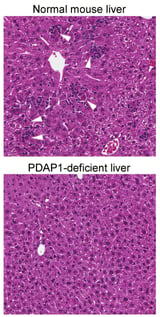Newly Identified Protein PDAP1 Found Crucial for Hepatitis A Virus Replication
November 21, 2024
In a mouse model, the absence of PDAP1 rendered the mice resistant to hepatitis A infection, further confirming the protein's vital role in the virus's life cycle.
Prior to this research, PDAP1 was largely uncharacterized, with limited literature linking it to gastrointestinal cancers and glioblastoma, prompting further investigation into its function in hepatitis A infection.
Lemon anticipates that this research will lead to further studies on PDAP1's role in cell survival and stress responses, with implications for cancer and metabolic diseases.
The findings suggest that understanding the mechanisms of the hepatitis A virus can provide insights into cellular processes relevant to both infectious and metabolic diseases, as well as cancer.
Hepatitis A virus is highly contagious and can cause severe liver inflammation, with 45,000 confirmed cases and 424 deaths reported in the U.S. since 2016, despite the availability of a vaccine since the 1990s.
Research indicates that PDAP1 is vital for maintaining cellular stress responses in immune cells, which are responsible for producing antibodies against infections.
Stanley M. Lemon has been studying hepatitis A and similar viruses since the 1980s, contributing significantly to the understanding of the virus's interaction with liver cells and its impact on human health.
Recent research led by Stanley M. Lemon, MD, published on November 20, 2024, has identified a protein called PDGFA-associated protein 1 (PDAP1) as crucial for the hepatitis A virus's ability to replicate inside liver cells.
The discovery of PDAP1 came from a CRISPR screen analyzing over 19,000 human genes, which identified about 40 essential genes for hepatitis A replication.
The study revealed that PDAP1 is critical for liver cell survival during stress and allows the hepatitis A virus to hijack the cellular stress response for its own replication.
Viruses have been part of human evolution for thousands of years, adapting to utilize cellular machinery for replication and survival.
The interconnectedness of viral and cellular biology highlighted by these findings suggests that PDAP1 could be a target for further research in infectious diseases, metabolic diseases, and cancer.
Summary based on 4 sources
Get a daily email with more Science stories
Sources

ScienceDaily • Nov 21, 2024
Scientists implicate a novel cellular protein in hepatitis A infection
EurekAlert! • Nov 21, 2024
Scientists implicate a novel cellular protein in hepatitis A infection
Medical Xpress • Nov 21, 2024
Scientists implicate a novel cellular protein in hepatitis A infection
Newsroom • Nov 20, 2024
Scientists Implicate a Novel Cellular Protein in Hepatitis A Infection | Newsroom